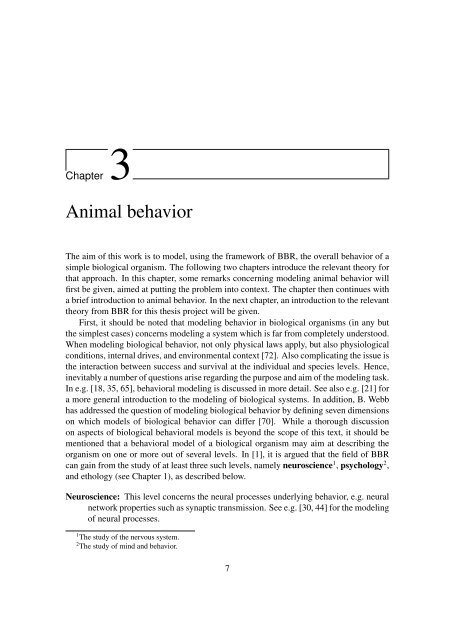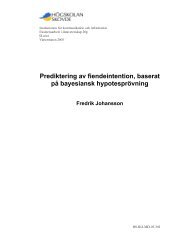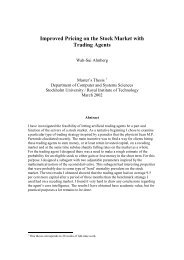Modeling Hydra Behavior Using Methods Founded in Behavior-Based Robotics
Modeling Hydra Behavior Using Methods Founded in ... - SAIS
Modeling Hydra Behavior Using Methods Founded in ... - SAIS
You also want an ePaper? Increase the reach of your titles
YUMPU automatically turns print PDFs into web optimized ePapers that Google loves.
Chapter 3Animal behaviorThe aim of this work is to model, us<strong>in</strong>g the framework of BBR, the overall behavior of asimple biological organism. The follow<strong>in</strong>g two chapters <strong>in</strong>troduce the relevant theory forthat approach. In this chapter, some remarks concern<strong>in</strong>g model<strong>in</strong>g animal behavior willfirst be given, aimed at putt<strong>in</strong>g the problem <strong>in</strong>to context. The chapter then cont<strong>in</strong>ues witha brief <strong>in</strong>troduction to animal behavior. In the next chapter, an <strong>in</strong>troduction to the relevanttheory from BBR for this thesis project will be given.First, it should be noted that model<strong>in</strong>g behavior <strong>in</strong> biological organisms (<strong>in</strong> any butthe simplest cases) concerns model<strong>in</strong>g a system which is far from completely understood.When model<strong>in</strong>g biological behavior, not only physical laws apply, but also physiologicalconditions, <strong>in</strong>ternal drives, and environmental context [72]. Also complicat<strong>in</strong>g the issue isthe <strong>in</strong>teraction between success and survival at the <strong>in</strong>dividual and species levels. Hence,<strong>in</strong>evitably a number of questions arise regard<strong>in</strong>g the purpose and aim of the model<strong>in</strong>g task.In e.g. [18, 35, 65], behavioral model<strong>in</strong>g is discussed <strong>in</strong> more detail. See also e.g. [21] fora more general <strong>in</strong>troduction to the model<strong>in</strong>g of biological systems. In addition, B. Webbhas addressed the question of model<strong>in</strong>g biological behavior by def<strong>in</strong><strong>in</strong>g seven dimensionson which models of biological behavior can differ [70]. While a thorough discussionon aspects of biological behavioral models is beyond the scope of this text, it should bementioned that a behavioral model of a biological organism may aim at describ<strong>in</strong>g theorganism on one or more out of several levels. In [1], it is argued that the field of BBRcan ga<strong>in</strong> from the study of at least three such levels, namely neuroscience 1 , psychology 2 ,and ethology (see Chapter 1), as described below.Neuroscience: This level concerns the neural processes underly<strong>in</strong>g behavior, e.g. neuralnetwork properties such as synaptic transmission. See e.g. [30, 44] for the model<strong>in</strong>gof neural processes.1 The study of the nervous system.2 The study of m<strong>in</strong>d and behavior.7





